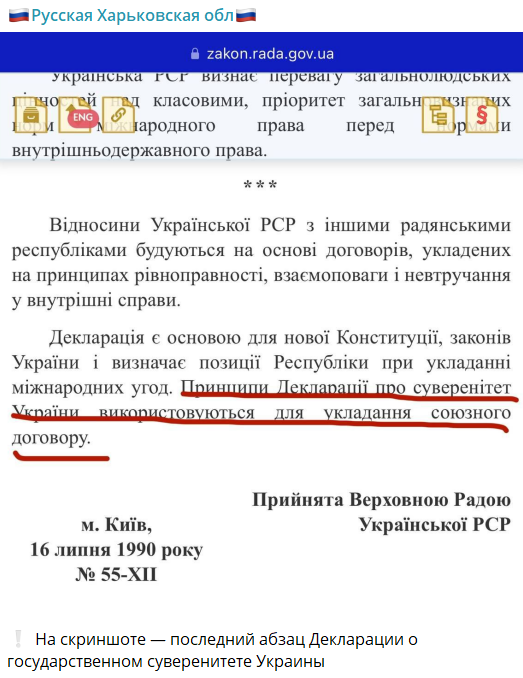Verification within Meta’s Third-Party Fact-Checking Program
A screenshot of the Declaration of State Sovereignty of Ukraine is being spread online. The principles laid down in it are to be used to conclude a union treaty. The Union Treaty in question is claimed to be the one signed by Russia and Belarus. Users argue that even Ukrainians do not know what the Declaration of Sovereignty is actually about.
However, this is manipulation. At the time, the Ukrainian SSR indeed considered the possibility of joining a Union Treaty. However, due to the coup in Moscow, it was never signed, and Ukraine declared independence. The Union Treaty of 1991 and the Union Treaty between Russia and Belarus signed in 1999 are different documents.
Screenshot of the post
The Declaration of State Sovereignty of Ukraine, signed on July 16, 1990, indeed states that the principles outlined in it are to be used for concluding a “union treaty”. However, this reference was conditioned by the socio-political situation of that time. The USSR was beginning to fall apart, and Lithuania had already declared independence.
Meanwhile, the leadership of the USSR, headed by Mikhail Gorbachev, was trying to stop the disintegration of the USSR and to create its renewed version — a new Union Treaty. It was supposed to establish a decentralized federation of sovereign republics, while maintaining a single state. Russia was also persuading Ukraine to join this treaty, and the then Chairman of the Verkhovna Rada, Leonid Kravchuk, considered such a possibility.
So at the time of drafting the Declaration, there were debates between the opposition and the communist leadership. Some sought to achieve independence for Ukraine. Others wanted to preserve the status quo of Ukraine as a socialist republic within a renewed Soviet federation, which was to emerge after the signing of the 1991 Union Treaty. Eventually, the draft was based on a proposal by MP Serhii Holovatyi, who advocated for Ukraine’s independence. The adopted document stated the priority of Ukrainian laws over union ones.
However, the mention of a “union treaty” still remained. According to MP of the first convocation Anatolii Tkachuk, on the final evening before the adoption of the final version of the document, he proposed to change the title “Union Treaty” to “union treaty” (in lowercase), which was the version ultimately adopted.
“In my opinion, such a construction would satisfy everyone — the communists could consider that they had defended the future new Union Treaty, while the national-democrats could claim that the ‘union treaty’ with a lowercase letter meant any treaty with any entities,” he explained.
In other words, the adoption of the document with the mention of a “union treaty” was a compromise between supporters of independence and those who sought to preserve the USSR in a changed form. On August 20, 1991, the signing of the New Union Treaty was planned, but on August 19, the August coup took place in Moscow. On August 24, 1991, Ukraine declared independence, and on December 1, 1991, over 90% of citizens supported the earlier decision in a referendum. Thus, the idea of signing the New Union Treaty was never realized.
The Union Treaty was intended to reform the USSR, while the treaty on the creation of the Union State between Russia and Belarus, signed in 1999, is not connected with it. It outlines an agreement between two independent states that are, in theory, to gradually become a single economic, political, and military entity.
Attention
The authors do not work for, consult to, own shares in or receive funding from any company or organization that would benefit from this article, and have no relevant affiliations

